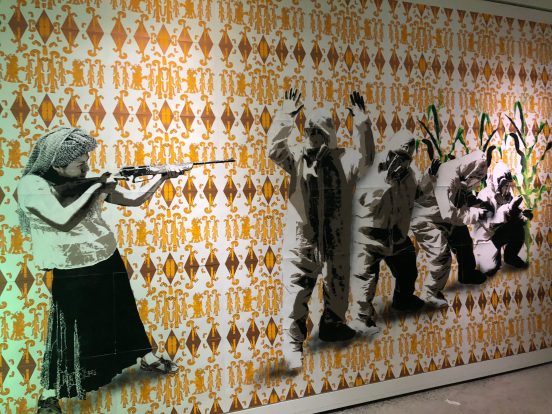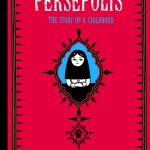Last week, I had the wonderful opportunity of visiting the Museum of Anthropology in Vancouver and seeing the incredible exhibit, Arts of Resistance. Arts of Resistance, curated by Laura Osorio Sunnucks, features works of Latin American artists showing how they use modern and traditional forms of arts to showcase current and historical political struggle, with a special emphasis on the marginalized communities.
An object that immediately caught my attention was an installation called Defence of the Maize, a graffiti by Oaxacan collective, Lapiztola. Made in 2006 during the Oaxacan protests against the introduction of transgenic maize in Mexico, this exhibit shows an Indigenous woman from the Mixe community of Oaxacan, Mexico pointing a rifle at the engineer of genetically modified maize. As explained by the display board in the Museum, these stencils use intricate designs of pre-hispanic imagery, such as ancient Central American maize symbols and the Aztec maize goddess, Centeotl to call attention to several issues that have originated from the authorization of bioengineered Maize in Mexico. Maize has been of immense historical and cultural significance to several communities in Mesoamerica. For centuries, maize has not only been a dietary staple for these communities, but has also formed the basis of the origin of several of their myths, rituals, and art.

The introduction of transgenic Maize is both culturally and economically unfair to the Indigenous communities. This object made me think of several forms of injustice that these communities have been facing due to the neo-colonialist measures of the Mexican government, some of which I wish to discuss in this blog.
The Economic Exploitation of the Cultivators
Transgenic maize has been used as a symbol to illustrate the ongoing economic exploitation of Indigenous communities. While the Mexican state defended the introduction of transgenic maize by stating benefits like increased productivity and farmers’ income, environmental benefits, and reduced poverty, the opposite has been true. The genetically modified crop has led to loss of jobs, such as the those for manual weeding and pesticide application. As Ms. Laura explained, these seeds actually require the use of more chemicals and fertilizers and pose the danger of stripping the soil of its fertility. Most importantly, due to the cheap price of transgenic maize, it is taking over the market and making non-transgenic maize production too unprofitable to continue with for these people, endangering their livelihoods.

Threatening Indigenous Culture
As previously mentioned, maize is not just a source of livelihood for these people, it is also a cultural symbol. Maize has been a significant crop in Mesoamerica for years. Aside from being a primary source of food, it also has religious and cultural significance with many of the Mayan traditions and legends revolving around maize. Many of the Mayan historical artifacts have images of maize on them. Hun Hunahpu, or the Maize God, is a very significant Mayan deity.

Transnational companies and the government threatening to take over maize production and trade also threaten the very cultural and spiritual identity of these people which is so heavily reliant on maize. If maize production becomes unprofitable for these farmers, eventually they might move away from it to produce other crops, leading to the gradual diminishing of an important cultural symbol. Cultural symbols are powerful sources of both individual and community identities. Robbing these people of these symbols not only threatens the sanctity of these intimate and important connections but for me, it also raises the question of whether it is even ethical for outside agencies to exercise a say on something so personal and meaningful, especially when these arbitrary decisions are not even benefitting these communities in any way.
Appropriation of Indigenous Culture
The issue that affected me the most profoundly is how cultural symbols like maize, or tribal land, are often ignored in favour of the economic convenience of the major agencies.
Governments and organizations employ major selectivity in “advocating” for the preservation of Indigenous culture. Objects such as art, clothing, or food are heavily spoken about because these are marketable and can easily be earned profits from. This is a form of cultural appropriation, which means “the act of taking or using things from a culture that is not your own, especially without showing that you understand or respect this culture” (Cambridge Dictionary). This ultimately leads to the commodification of indigenous culture, or turning cultural products into marketable products by capitalist firms, while Indigenous people receive no share of the profits.
This can lead to a feeling of dehumanization as these communities are reduced to mere sources of profit that governments pay attention to only when it benefits them. Moreover, these people feel alienated and oppressed as they do not get a say in which parts of their culture are saved and which are left to perish. As someone who herself comes from a culture that is heavily appropriated and marketed in the West, the cultural plight of these communities fills me with both rage and grief.
Before visiting the museum, I was completely unaware of the oppression of the Indigenous communities in Latin America. However, looking at this exhibit, and Defence of the Maize, in particular, allowed me to recognize an ongoing global pattern of Indigenous exploitation. Many of the issues that this object highlighted for me are similar to the ones being faced by Indigenous communities in my home country as well. For example, In India, tribal communities have been left homeless and reduced to daily-wage workers due to the forceful acquisition of tribal lands and resources by the government in the name of development. Many tribal communities are also forced to work as labourers and to sell their art to big firms, which then make huge profits from these “tribal designs”. However, these workers are heavily exploited while the state continues to ignore it. Sometimes entire tribal clans commit suicides because of this. Similarly, I was both distraught and shocked when I learned about the unfairness towards the First Nations upon my arrival in Canada, such as with the Trans Mountain Pipeline expansion. This shows that the current form of seemingly democratic decision-making process all across the world excludes Indigenous communities even though these decisions have a profound effect on their very existence. The issue pertains to not just the loss of their rich culture and valuable knowledge cultures but also the reduction of these people as lesser human beings.
Visiting the exhibit shocked me into truly opening my eyes and seeing the reality of the ongoing mode of development which I benefit from every day, but which comes at a cost of the exploitation of a million others. However, it also filled me with hope because exhibits like Arts of Resistance allow these communities to amplify their voices and make them heard far and wide, so that someday, they might gain a place in this world as equals.
References:
https://dictionary.cambridge.org/dictionary/english/cultural-appropriation
https://www.thoughtco.com/centeotl-the-aztec-god-of-maize-170309
https://www.nature.com/news/gm-maize-splits-mexico-1.15493
https://jen-wilton.com/2014/10/02/the-rise-of-revolutionary-street-art-in-oaxaca-mexico/
https://www.indiatoday.in/featured/story/suicides-among-tribals-tribals-upa-kerala-212453-2013-09-27

